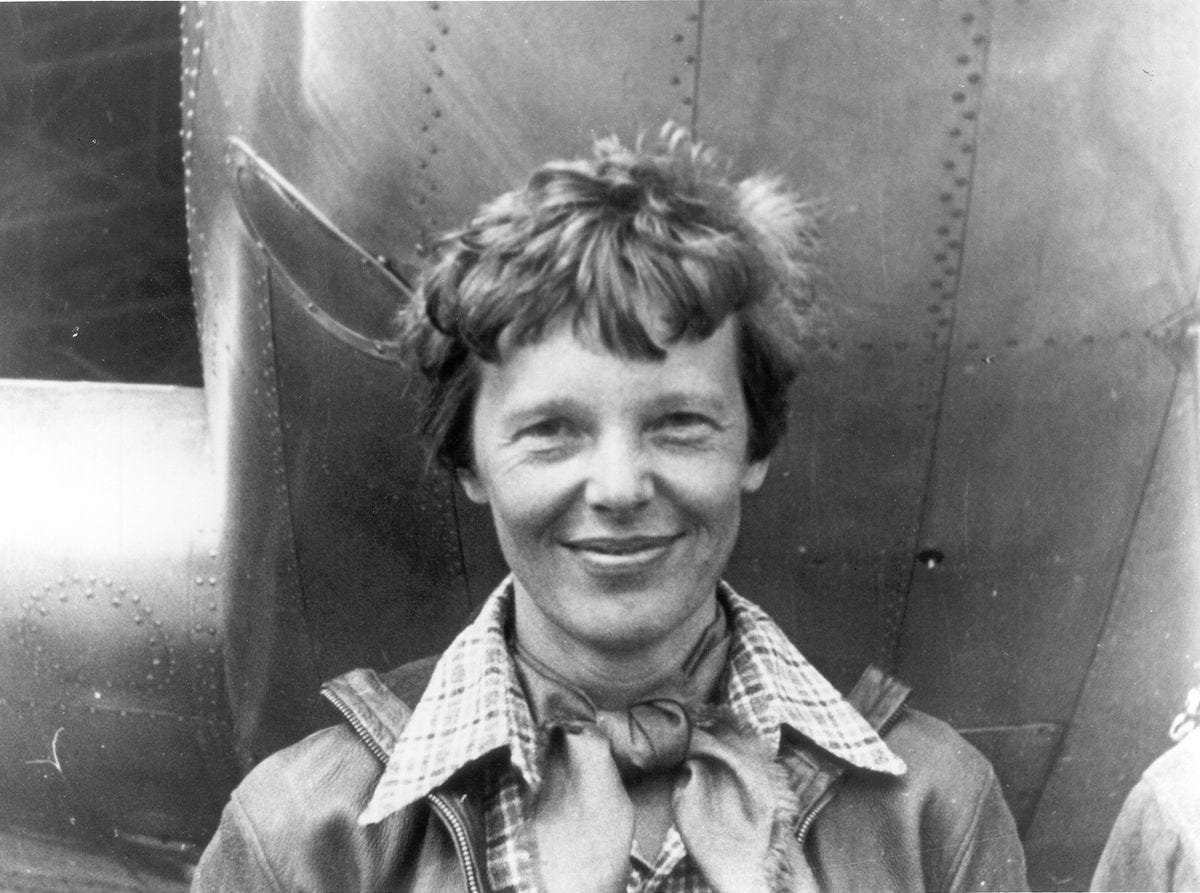TDIH: Amelia Earhart's record-setting flight
As Earhart climbed into the cockpit, she “sighted three fire engines and an ambulance posted down the field where ‘X’ might be expected to mark the spot if an accident occurred.”
On this day in 1935, Amelia Earhart departs from Honolulu. The flight that followed would make her the first person to fly solo from Hawaii to the mainland.
She’d been preparing for months.
“I have long preached,” she later wrote, “that two-thirds of the success of any expedition is in the preparation.” And there was a lot to do!
Each of nine tanks on her plane had to be checked, not only at different altitudes, but also at different capacities. Did they operate smoothly when full—and also when nearly empty? Moreover, Earhart herself had to determine how much gasoline and oil her plane could be expected to use in a variety of circumstances.
Today, we might expect a specific model of airplane to come with specs dictating what the fuel efficiency would be under certain conditions. Earhart had no such luxury.
Navigation charts and weather forecasts were two more huge tasks—easier today than they were back then. “The charts called for fourteen changes in compass course,” she told National Geographic, “each to be made at intervals slightly over one hour.” Thus, she kept three clocks in the cockpit to help her calculate time.
A final hurdle came when Earhart’s sponsors balked at sponsoring her. “Amelia faced the association’s committee,” one of her biographers writes, “and scathingly told them that she could sense an aroma of cowardice in the room. . . . She got their support.”
By late December 1934, Earhart was ready. She boarded a steamship headed for Hawaii. Her little Lockheed Vega was secured on deck, she joked, “as only sailors could do it.”
Even then, preparations couldn’t stop. Earhart and her crew tested the radio and ran the Vega’s motor. Moisture from the salty sea couldn’t be allowed to corrode anything on the plane during the five-day ocean voyage.
The day of Earhart’s flight opened with rain. Should she delay? The rain would make the ground soft. Her plane would be heavy, loaded with extra gasoline. But Earhart worried about being delayed indefinitely. The runway was long, and she thought she could do it. When a break in the rain came, she seized the opportunity.
As she climbed into the cockpit, she spotted “several women with handkerchiefs obviously ready for any emergency.” In another direction, she “sighted three fire engines and an ambulance posted down the field where ‘X’ might be expected to mark the spot if an accident occurred.”
Everywhere she looked, someone was holding a portable fire extinguisher.
Nevertheless, Earhart wasn’t one to hold back. “[She] gave the plane the gun,” The New York Times would report, “and got up quickly. As the ship went down the runway the propeller blast blew big chunks of mud from the field and over the red fuselage.”
Despite earlier concerns, she made it off the ground without difficulty. In fact, she was so well prepared, overall, that the flight itself was mostly uneventful.
Her biggest problem turned out to be fog—but even the fog brought funny moments.
Earhart had been using a two-way radio telephone to send updates. During one of these updates, she mumbled: “I am getting tired of this fog.” But the only words that filtered back to the mainland were: “I am getting tired.”
“So shore radio announcers,” she laughed, “bless them, had fresh ammunition for their word pictures of the little girl battling exhaustion as well as the elements.”
One of her best memories of the flight, believe it or not, was a “memorable” cup of hot chocolate. “Drinking hot chocolate alone over the Pacific at 8,000 feet,” she wrote later, “is a unique experience I shall not soon forget.”
Another comforting moment came just before midnight when she noticed searchlights cutting through the darkness. Earhart quickly flashed her landing lights in response, then was gratified to hear the vessel report back to shore that he’d seen her plane.
The flight finally came to an end more than 18 hours after she’d left Hawaii.
“At Oakland Airport a good ten thousand had been waiting for several hours,” one of her biographers writes, “yet when she came in she surprised them. They had been craning their necks looking for a lone aircraft flying high and obviously seeking a place to land. But Amelia did not even circle the field; she brought the Vega in straight as an arrow . . . .”
As for Earhart, she felt that her feat would lead to regular air travel over the ocean. “I wanted the flight just to contribute,” she said. “I could only hope one more passage across that part of the Pacific would mark a little more clearly the pathway over which an air service of the future will inevitably ply.”
The “air service of the future” came to be, as we all know. If only she could have lived to see it.
Sources can always be found on my website, here.





As a pilot in a lone Army Helicopter, flying missions into the High Italian Alps in the early 1970s ... I can fully appreciate Amelia's many concerns ... for the unknowns coming up in flight. Getting over Valleys and areas that are "socked in" not sure of the conditions at the destinations.. But then again, seeing the Hand of God , so to speak, on a quiet mountain evening, flying into the Sunset, and knowing your almost home. and all your decisions were good ones.
Amelia Earhart loved flying and exploring and she challenged herself to be the first on a number of occasions, much like Charles Lindbergh. She did much to knock down obstacles confronting women and flying in general and her bravery and skill did much for the aviation industry. Thank you Tara.